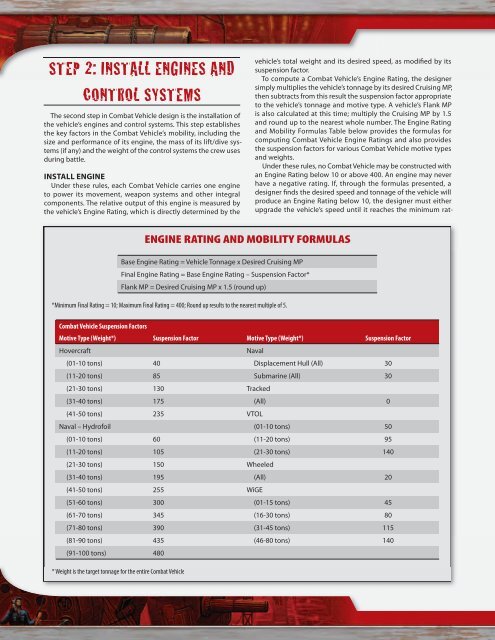the shape of things to come
the shape of things to come
the shape of things to come
Create successful ePaper yourself
Turn your PDF publications into a flip-book with our unique Google optimized e-Paper software.
STEP 2: INSTALL ENGINES AND<br />
CONTROL SYSTEMS<br />
The second step in Combat Vehicle design is <strong>the</strong> installation <strong>of</strong><br />
<strong>the</strong> vehicle’s engines and control systems. This step establishes<br />
<strong>the</strong> key fac<strong>to</strong>rs in <strong>the</strong> Combat Vehicle’s mobility, including <strong>the</strong><br />
size and performance <strong>of</strong> its engine, <strong>the</strong> mass <strong>of</strong> its lift/dive systems<br />
(if any) and <strong>the</strong> weight <strong>of</strong> <strong>the</strong> control systems <strong>the</strong> crew uses<br />
during battle.<br />
INSTALL ENGINE<br />
Under <strong>the</strong>se rules, each Combat Vehicle carries one engine<br />
<strong>to</strong> power its movement, weapon systems and o<strong>the</strong>r integral<br />
components. The relative output <strong>of</strong> this engine is measured by<br />
<strong>the</strong> vehicle’s Engine Rating, which is directly determined by <strong>the</strong><br />
ENGINE RATING AND MOBILITY FORMULAS<br />
Base Engine Rating = Vehicle Tonnage x Desired Cruising MP<br />
Final Engine Rating = Base Engine Rating – Suspension Fac<strong>to</strong>r*<br />
Flank MP = Desired Cruising MP x 1.5 (round up)<br />
*Minimum Final Rating = 10; Maximum Final Rating = 400; Round up results <strong>to</strong> <strong>the</strong> nearest multiple <strong>of</strong> 5.<br />
vehicle’s <strong>to</strong>tal weight and its desired speed, as modifi ed by its<br />
suspension fac<strong>to</strong>r.<br />
To compute a Combat Vehicle’s Engine Rating, <strong>the</strong> designer<br />
simply multiplies <strong>the</strong> vehicle’s <strong>to</strong>nnage by its desired Cruising MP,<br />
<strong>the</strong>n subtracts from this result <strong>the</strong> suspension fac<strong>to</strong>r appropriate<br />
<strong>to</strong> <strong>the</strong> vehicle’s <strong>to</strong>nnage and motive type. A vehicle’s Flank MP<br />
is also calculated at this time; multiply <strong>the</strong> Cruising MP by 1.5<br />
and round up <strong>to</strong> <strong>the</strong> nearest whole number. The Engine Rating<br />
and Mobility Formulas Table below provides <strong>the</strong> formulas for<br />
computing Combat Vehicle Engine Ratings and also provides<br />
<strong>the</strong> suspension fac<strong>to</strong>rs for various Combat Vehicle motive types<br />
and weights.<br />
Under <strong>the</strong>se rules, no Combat Vehicle may be constructed with<br />
an Engine Rating below 10 or above 400. An engine may never<br />
have a negative rating. If, through <strong>the</strong> formulas presented, a<br />
designer fi nds <strong>the</strong> desired speed and <strong>to</strong>nnage <strong>of</strong> <strong>the</strong> vehicle will<br />
produce an Engine Rating below 10, <strong>the</strong> designer must ei<strong>the</strong>r<br />
upgrade <strong>the</strong> vehicle’s speed until it reaches <strong>the</strong> minimum rat-<br />
Combat Vehicle Suspension Fac<strong>to</strong>rs<br />
Motive Type (Weight*) Suspension Fac<strong>to</strong>r Motive Type (Weight*) Suspension Fac<strong>to</strong>r<br />
Hovercraft Naval<br />
(01-10 <strong>to</strong>ns) 40 Displacement Hull (All) 30<br />
(11-20 <strong>to</strong>ns) 85 Submarine (All) 30<br />
(21-30 <strong>to</strong>ns) 130 Tracked<br />
(31-40 <strong>to</strong>ns) 175 (All) 0<br />
(41-50 <strong>to</strong>ns) 235 VTOL<br />
Naval – Hydr<strong>of</strong>oil (01-10 <strong>to</strong>ns) 50<br />
(01-10 <strong>to</strong>ns) 60 (11-20 <strong>to</strong>ns) 95<br />
(11-20 <strong>to</strong>ns) 105 (21-30 <strong>to</strong>ns) 140<br />
(21-30 <strong>to</strong>ns) 150 Wheeled<br />
(31-40 <strong>to</strong>ns) 195 (All) 20<br />
(41-50 <strong>to</strong>ns) 255 WiGE<br />
(51-60 <strong>to</strong>ns) 300 (01-15 <strong>to</strong>ns) 45<br />
(61-70 <strong>to</strong>ns) 345 (16-30 <strong>to</strong>ns) 80<br />
(71-80 <strong>to</strong>ns) 390 (31-45 <strong>to</strong>ns) 115<br />
(81-90 <strong>to</strong>ns) 435 (46-80 <strong>to</strong>ns) 140<br />
(91-100 <strong>to</strong>ns) 480<br />
* Weight is <strong>the</strong> target <strong>to</strong>nnage for <strong>the</strong> entire Combat Vehicle


